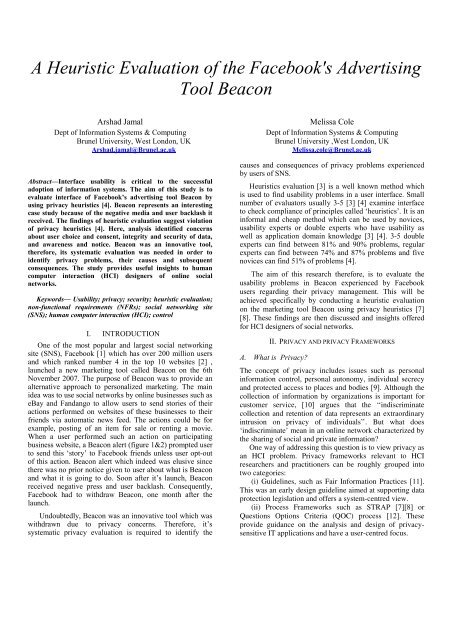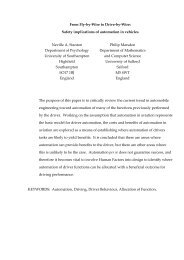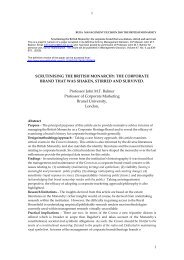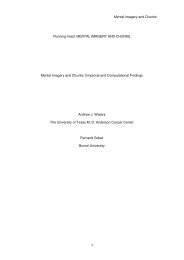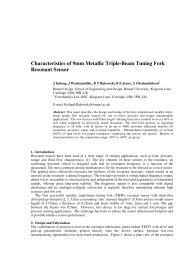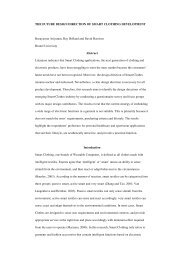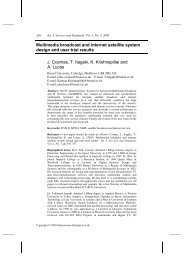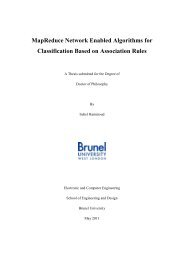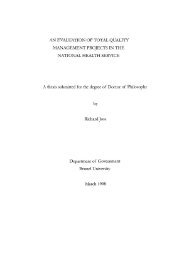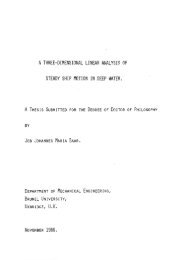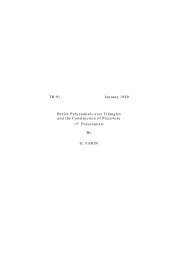A Heuristic Evaluation of the Facebook's ... - Brunel University
A Heuristic Evaluation of the Facebook's ... - Brunel University
A Heuristic Evaluation of the Facebook's ... - Brunel University
You also want an ePaper? Increase the reach of your titles
YUMPU automatically turns print PDFs into web optimized ePapers that Google loves.
A <strong>Heuristic</strong> <strong>Evaluation</strong> <strong>of</strong> <strong>the</strong> <strong>Facebook's</strong> Advertising<br />
Tool Beacon<br />
Arshad Jamal<br />
Dept <strong>of</strong> Information Systems & Computing<br />
<strong>Brunel</strong> <strong>University</strong>, West London, UK<br />
Arshad.jamal@<strong>Brunel</strong>.ac.uk<br />
Abstract—Interface usability is critical to <strong>the</strong> successful<br />
adoption <strong>of</strong> information systems. The aim <strong>of</strong> this study is to<br />
evaluate interface <strong>of</strong> Facebook’s advertising tool Beacon by<br />
using privacy heuristics [4]. Beacon represents an interesting<br />
case study because <strong>of</strong> <strong>the</strong> negative media and user backlash it<br />
received. The findings <strong>of</strong> heuristic evaluation suggest violation<br />
<strong>of</strong> privacy heuristics [4]. Here, analysis identified concerns<br />
about user choice and consent, integrity and security <strong>of</strong> data,<br />
and awareness and notice. Beacon was an innovative tool,<br />
<strong>the</strong>refore, its systematic evaluation was needed in order to<br />
identify privacy problems, <strong>the</strong>ir causes and subsequent<br />
consequences. The study provides useful insights to human<br />
computer interaction (HCI) designers <strong>of</strong> online social<br />
networks.<br />
Keywords— Usability; privacy; security; heuristic evaluation;<br />
non-functional requirements (NFRs); social networking site<br />
(SNS); human computer interaction (HCI); control<br />
I. INTRODUCTION<br />
One <strong>of</strong> <strong>the</strong> most popular and largest social networking<br />
site (SNS), Facebook [1] which has over 200 million users<br />
and which ranked number 4 in <strong>the</strong> top 10 websites [2] ,<br />
launched a new marketing tool called Beacon on <strong>the</strong> 6th<br />
November 2007. The purpose <strong>of</strong> Beacon was to provide an<br />
alternative approach to personalized marketing. The main<br />
idea was to use social networks by online businesses such as<br />
eBay and Fandango to allow users to send stories <strong>of</strong> <strong>the</strong>ir<br />
actions performed on websites <strong>of</strong> <strong>the</strong>se businesses to <strong>the</strong>ir<br />
friends via automatic news feed. The actions could be for<br />
example, posting <strong>of</strong> an item for sale or renting a movie.<br />
When a user performed such an action on participating<br />
business website, a Beacon alert (figure 1&2) prompted user<br />
to send this ‘story’ to Facebook friends unless user opt-out<br />
<strong>of</strong> this action. Beacon alert which indeed was elusive since<br />
<strong>the</strong>re was no prior notice given to user about what is Beacon<br />
and what it is going to do. Soon after it’s launch, Beacon<br />
received negative press and user backlash. Consequently,<br />
Facebook had to withdraw Beacon, one month after <strong>the</strong><br />
launch.<br />
Undoubtedly, Beacon was an innovative tool which was<br />
withdrawn due to privacy concerns. Therefore, it’s<br />
systematic privacy evaluation is required to identify <strong>the</strong><br />
Melissa Cole<br />
Dept <strong>of</strong> Information Systems & Computing<br />
<strong>Brunel</strong> <strong>University</strong> ,West London, UK<br />
Melissa.cole@<strong>Brunel</strong>.ac.uk<br />
causes and consequences <strong>of</strong> privacy problems experienced<br />
by users <strong>of</strong> SNS.<br />
<strong>Heuristic</strong>s evaluation [3] is a well known method which<br />
is used to find usability problems in a user interface. Small<br />
number <strong>of</strong> evaluators usually 3-5 [3] [4] examine interface<br />
to check compliance <strong>of</strong> principles called ‘heuristics’. It is an<br />
informal and cheap method which can be used by novices,<br />
usability experts or double experts who have usability as<br />
well as application domain knowledge [3] [4]. 3-5 double<br />
experts can find between 81% and 90% problems, regular<br />
experts can find between 74% and 87% problems and five<br />
novices can find 51% <strong>of</strong> problems [4].<br />
The aim <strong>of</strong> this research <strong>the</strong>refore, is to evaluate <strong>the</strong><br />
usability problems in Beacon experienced by Facebook<br />
users regarding <strong>the</strong>ir privacy management. This will be<br />
achieved specifically by conducting a heuristic evaluation<br />
on <strong>the</strong> marketing tool Beacon using privacy heuristics [7]<br />
[8]. These findings are <strong>the</strong>n discussed and insights <strong>of</strong>fered<br />
for HCI designers <strong>of</strong> social networks.<br />
II. PRIVACY AND PRIVACY FRAMEWORKS<br />
A. What is Privacy?<br />
The concept <strong>of</strong> privacy includes issues such as personal<br />
information control, personal autonomy, individual secrecy<br />
and protected access to places and bodies [9]. Although <strong>the</strong><br />
collection <strong>of</strong> information by organizations is important for<br />
customer service, [10] argues that <strong>the</strong> ‘‘indiscriminate<br />
collection and retention <strong>of</strong> data represents an extraordinary<br />
intrusion on privacy <strong>of</strong> individuals’’. But what does<br />
‘indiscriminate’ mean in an online network characterized by<br />
<strong>the</strong> sharing <strong>of</strong> social and private information?<br />
One way <strong>of</strong> addressing this question is to view privacy as<br />
an HCI problem. Privacy frameworks relevant to HCI<br />
researchers and practitioners can be roughly grouped into<br />
two categories:<br />
(i) Guidelines, such as Fair Information Practices [11].<br />
This was an early design guideline aimed at supporting data<br />
protection legislation and <strong>of</strong>fers a system-centred view.<br />
(ii) Process Frameworks such as STRAP [7][8] or<br />
Questions Options Criteria (QOC) process [12]. These<br />
provide guidance on <strong>the</strong> analysis and design <strong>of</strong> privacysensitive<br />
IT applications and have a user-centred focus.
B. Privacy Framework: Structured Analysis <strong>of</strong> Privacy<br />
Structured Analysis <strong>of</strong> Privacy (STRAP) framework [7]<br />
[8] <strong>of</strong>fers 11 dedicated set <strong>of</strong> privacy heuristics intended for<br />
use by designers to analyze interactive systems. See table 1<br />
for details <strong>of</strong> heuristics. Modelled on usability heuristics [3]<br />
and fair information practices [11], <strong>the</strong> STRAP framework<br />
is a structured means <strong>of</strong> analyzing non-functional user<br />
requirements (NFRs) [7] [8]. There are two reasons to<br />
choose STRAP heuristics for <strong>the</strong> evaluation <strong>of</strong> Beacon. First<br />
is <strong>the</strong> assumption that designers are generally not good at<br />
addressing a social issue (e.g. privacy) in <strong>the</strong> design <strong>of</strong><br />
information systems. Thus, <strong>the</strong>y need an easy to use and<br />
light weight (easy to learn) tool to address social issues like<br />
privacy. Secondly, because <strong>of</strong> <strong>the</strong> benefits associated with<br />
heuristic evaluation method and it’s reputation as a cheap<br />
and effective method [3] [4].<br />
Moreover, STRAP heuristics were tested for efficiency<br />
and effectiveness by [8] and found <strong>the</strong> tool useful to<br />
discover privacy, security and associated usability problems.<br />
By efficiency [8] means e.g. how many privacy problems<br />
can be located in unit time and effectiveness means total<br />
number <strong>of</strong> privacy issues found as effectiveness. However,<br />
this study is <strong>the</strong> first that uses STRAP heuristics [7] [8] in<br />
<strong>the</strong> privacy evaluation <strong>of</strong> online social networks.<br />
III. HEURISTIC EVALUATION OF BEACON<br />
A. Evaluators and evaluation process<br />
Three evaluators performed heuristic evaluation <strong>of</strong><br />
Beacon using STRAP heuristics [7]. All three evaluators<br />
Notice /Awareness<br />
Choice /Consent<br />
Integrity /<br />
Security<br />
Enforce/ Redress<br />
Figure 1. Early Beacon Alert<br />
TABLE I. STRAP HEURISTICS [4][5]<br />
including author 1 have HCI background and experience <strong>of</strong><br />
using heuristic evaluation method. They also have pr<strong>of</strong>iles<br />
on Facebook. Author 1 also has background domain<br />
knowledge <strong>of</strong> privacy <strong>the</strong>ories and principles. Therefore, <strong>the</strong><br />
team has expertise in both heuristic evaluation method and<br />
<strong>the</strong> domain knowledge. Each evaluator performed<br />
evaluation separately to avoid influence <strong>of</strong> one evaluator’s<br />
work on <strong>the</strong> o<strong>the</strong>r. Each evaluator applied 11 privacy<br />
heuristics [7] on Beacon interface (shown in figure 1&2) to<br />
see whe<strong>the</strong>r it is violated or not. Three lists <strong>of</strong> evaluations<br />
are produced. Subsequently, each evaluator recorded<br />
severity rating <strong>of</strong> violated privacy heuristics. Each problem<br />
is measured along a continuous scale: very serious, serious,<br />
minor, and no problem. Following severity ratings are used<br />
as suggested by [6]: 0= I don’t agree that this is a usability<br />
/privacy problem; 1= Minor problem and should not be<br />
given low priority; 2= Serious problem and should be given<br />
high priority, 3=Very serious problem and should be given<br />
very high priority. Three lists <strong>of</strong> individual severity ratings<br />
are compiled into a single list. The mean severity ratings<br />
and standard deviation (SD) <strong>of</strong> each problem are computed.<br />
We also computed complete consensus (as a percentage) to<br />
show consistency between <strong>the</strong> ratings.<br />
B. Analysis <strong>of</strong> Results<br />
Table 2 provides a breakdown <strong>of</strong> <strong>the</strong> usability problems<br />
encountered in Beacon and shows <strong>the</strong> means and standard<br />
deviations <strong>of</strong> severity ratings <strong>of</strong> <strong>the</strong> problems.<br />
<strong>Heuristic</strong> Description<br />
Available, Accessible and clear Make information about <strong>the</strong> systems activities always available to users and simple to access and<br />
understand<br />
Correct, Complete and consistent Ensure that disclosures are complete, correct and consistent for users to make informed decisions<br />
Presented in context<br />
Not overburdening<br />
Relevant information should be presented for each transaction to minimize memory load and ensure<br />
users are aware <strong>of</strong> consequences <strong>of</strong> actions<br />
Disclosure must take into account human limitations in memory, ability and interest. Provide succinct<br />
and relevant information<br />
Meaningful Options<br />
Users need to be given real options ra<strong>the</strong>r than opt-in/opt-out when possible to avoid coercion and<br />
maximize benefits<br />
Appropriate defaults Default settings should reflect most users’ concerns and expectations about privacy<br />
Explicit consent Avoid assuming consent whenever possible.<br />
Awareness <strong>of</strong> security mechanisms Users should be provided with enough information to judge security <strong>of</strong> system and <strong>the</strong>ir information<br />
Transparency <strong>of</strong> transactions Systems should provide transparency <strong>of</strong> transactions and data use to build user confidence and trust<br />
Access to own record Users should have access to all information <strong>the</strong> system has collected about <strong>the</strong>m, regardless <strong>of</strong> source<br />
Ability to revoke consent Consent should be retractable<br />
Figure 2. Final Version <strong>of</strong> Beacon Alert
The mean severity rating <strong>of</strong> 3 shows a very serious<br />
problem where as 0 shows <strong>the</strong> absence <strong>of</strong> problem. For an<br />
illustration, problem 6 has mean severity rating <strong>of</strong> 3, SD <strong>of</strong><br />
0 and complete consensus 100%. Because all three<br />
evaluators gave a rating <strong>of</strong> 3 to problem 6 which states that<br />
‘Default settings do not reflect most users’ concerns and<br />
expectations about privacy e.g. beacon uses opt-out and<br />
users expected opt-in’. Therefore, <strong>the</strong> mean severity rating<br />
for this problem is 3, with zero SD and 100% complete<br />
consensus. Out <strong>of</strong> 11 problems, 5 problems (46%) were<br />
very serious, 4 problems (36%) were serious, and 2<br />
problems (18%) were minor problems. So, 82% <strong>of</strong> problems<br />
were serious. For all 5 very serious problems, SD is 0 and<br />
<strong>the</strong>re is complete consensus (100%) among <strong>the</strong> raters. Such<br />
high percentage <strong>of</strong> problems discovered in Beacon improves<br />
our understanding <strong>of</strong> <strong>the</strong> causes <strong>of</strong> severe user backlash and<br />
subsequent withdrawal <strong>of</strong> Beacon by <strong>the</strong> Facebook.<br />
The mean <strong>of</strong> <strong>the</strong> SD <strong>of</strong> all ratings is 0.44 which shows<br />
that severity ratings <strong>of</strong> evaluators are only dispersed<br />
marginally. To measure reliability and consistency <strong>of</strong> rater’s<br />
ratings, we computed general measure <strong>of</strong> agreement<br />
between raters. For example, <strong>the</strong> general measure <strong>of</strong><br />
agreement between rater 1 and rater 2 is 70%, between rater<br />
1 and rater 3 is 60% and between rater 2 and rater 3 is 70%.<br />
The mean general measure <strong>of</strong> agreement between raters is<br />
67% which is acceptable.<br />
IV. DISCUSSION<br />
It is clear from <strong>the</strong> privacy-focused heuristic evaluation<br />
<strong>of</strong> Beacon that all 11 heuristics were violated with <strong>the</strong><br />
greatest violations occurring with three privacy issues: user<br />
TABLE II. HEURISTIC EVALUATION OF BEACON USING STRAP<br />
Problems in Beacon<br />
Mean<br />
Severity<br />
Ratings<br />
Standard<br />
Deviation<br />
Lack <strong>of</strong> availability, accessibility and clarity <strong>of</strong> system information to user. 2.67 0.58 67%<br />
Notices to users are not correct, complete and consistent. 2 0 100%<br />
Relevant background information to users is not given for each transaction to understand <strong>the</strong><br />
context.<br />
2 1 33%<br />
Disclosure <strong>of</strong> information is not succinct and relevant ra<strong>the</strong>r user was not provided with complete<br />
information.<br />
1.33 1.15 67%<br />
Users are not given meaningful options to accept a service or feature or reject it. 3 0 100%<br />
Default settings do not reflect most users’ concerns and expectations about privacy, e.g. beacon<br />
uses opt-out and users expected opt-in.<br />
3 0 100%<br />
Explicit consent is not obtained. 2.33 0.58 67%<br />
Users are not given enough information to judge security <strong>of</strong> system and <strong>the</strong>ir information. 3 0 100%<br />
System does not provide transparency <strong>of</strong> transactions and data use to build user confidence and<br />
trust.<br />
Users do not have access to all information <strong>the</strong> system has collected about <strong>the</strong>m, regardless <strong>of</strong><br />
source<br />
3 0 100%<br />
1.33 1.53 33%<br />
Consent cannot be revoked 3 0 100%<br />
Complete<br />
Consensus<br />
choice and consent; notice and awareness; and integrity and<br />
security <strong>of</strong> data. The first two privacy issues are generally<br />
recognized by <strong>the</strong> HCI community to be <strong>the</strong> core principles<br />
for <strong>the</strong> successful design <strong>of</strong> s<strong>of</strong>tware applications. The issue<br />
<strong>of</strong> notice and awareness is challenging for designers to<br />
determine a striking balance between notices for awareness<br />
and minimum distraction for <strong>the</strong> users. These two issues<br />
toge<strong>the</strong>r determine <strong>the</strong> level <strong>of</strong> control users have when <strong>the</strong>y<br />
perform any action that requires sharing <strong>of</strong> personal<br />
information. On this occasion users were not given control<br />
on <strong>the</strong> use <strong>of</strong> personal information. This finding is in line<br />
with study performed by [13] to measure internet users’<br />
information privacy concerns. According to [13], control is<br />
important to determine information privacy and can be<br />
exercised via approval, modification, and choice to opt-in or<br />
opt-out. Beacon clearly made basic design errors and<br />
consequently end user was completely ignored. For<br />
example, user was not given a universal opt-out <strong>of</strong><br />
automatic feeds and had to opt-out on each occasion<br />
separately shows <strong>the</strong> bad intention to force user into<br />
accepting <strong>the</strong> automatic feeds by default. Surely, <strong>the</strong> user<br />
was not given control or freedom or authority to select or<br />
avoid sending user stories to a third party website.<br />
The third privacy issue, integrity and security <strong>of</strong> data,<br />
appears to reflect <strong>the</strong> unique concerns <strong>of</strong> sharing personal<br />
information online. The negative press and user outrage<br />
expands this by highlighting a user’s desire to be explicitly<br />
consulted by third parties who wish to use and transfer<br />
personal data. Users were not informed <strong>of</strong> <strong>the</strong> presence <strong>of</strong><br />
Beacon and also about its purpose. Consequently, users<br />
were alarmed when <strong>the</strong>ir stories <strong>of</strong> actions on participating
usiness sites were published on <strong>the</strong>ir Facebook news feed.<br />
Also, <strong>the</strong> users lost faith on third party organizations<br />
and <strong>the</strong>ir integrity was also questioned. End users were not<br />
sure that <strong>the</strong>ir individual interests would be protected when<br />
<strong>the</strong>ir personal browsing interests were automatically<br />
distributed across <strong>the</strong>ir ‘friends’ network. In this instance,<br />
users were primarily concerned with conducting a risk<br />
analysis on <strong>the</strong> indiscriminate transfer <strong>of</strong> personal<br />
information.<br />
Viewing privacy as risk analysis in online social<br />
networks raises two set <strong>of</strong> interesting points for HCI<br />
designers to consider. According to [14] <strong>the</strong> first set <strong>of</strong><br />
points (a, b, c, d) relate to <strong>the</strong> social and organizational<br />
context whilst <strong>the</strong> second set (i, ii, iii) highlight <strong>the</strong> nature<br />
and purpose <strong>of</strong> <strong>the</strong> technology used. With regard to user<br />
perceptions <strong>of</strong> Beacon, key questions to ask could include:<br />
a) Who are <strong>the</strong> people sharing personal information (data<br />
sharers) and who are <strong>the</strong> people that see <strong>the</strong> personal<br />
information (data observers)?<br />
b) What kinds <strong>of</strong> personal information are shared and under<br />
what circumstances?<br />
c) What is <strong>the</strong> value proposition for sharing information?<br />
d) Are <strong>the</strong>ir third parties that might be directly or indirectly<br />
impacted?<br />
i) How is personal information collected and shared? (Optin<br />
/ opt-out; pull / push)<br />
ii) How much information is shared? Is it discrete or<br />
continuous?<br />
iii) What is <strong>the</strong> quality <strong>of</strong> <strong>the</strong> information shared and how<br />
long is personal data retained?<br />
V. CONCLUSION<br />
Beacon was a novel marketing tool within <strong>the</strong> massively<br />
growing online social network environment. Beacon<br />
damaged <strong>the</strong> reputation <strong>of</strong> Facebook as well as third party<br />
organizations and consequently withdrawn due to lack <strong>of</strong><br />
understanding <strong>of</strong> <strong>the</strong> nature <strong>of</strong> privacy in social network.<br />
Our findings <strong>of</strong> <strong>the</strong> case study <strong>of</strong> Beacon confirms <strong>the</strong><br />
arguments <strong>of</strong> [15] that privacy should be viewed as a<br />
holistic feature <strong>of</strong> interactive systems and a poor interface<br />
or design component that leaks personal information and<br />
which is not usable may damage reputation <strong>of</strong> interactive<br />
systems [15].<br />
Usability property <strong>of</strong> privacy brings three facts into light<br />
in social networks (i) consent and choice and (ii) notice and<br />
awareness (iii) third party integrity and security <strong>of</strong><br />
transmitted data.<br />
Designers <strong>of</strong> social networks need to be aware <strong>of</strong> <strong>the</strong><br />
sensitivity <strong>of</strong> user information. Specifically, <strong>the</strong>y need to<br />
have a better view <strong>of</strong> <strong>the</strong> interaction between <strong>the</strong> social and<br />
organizational context. They also need to adhere <strong>the</strong> sociotechnical<br />
context <strong>of</strong> socially networked information (e.g.<br />
How is information shared and who has <strong>the</strong> control?). This<br />
study suggests that <strong>the</strong> individual users prefer to retain<br />
control over <strong>the</strong> type and nature <strong>of</strong> information shared. An<br />
interesting area for future research would be to determine<br />
<strong>the</strong> form and extent <strong>of</strong> user control using <strong>the</strong> risk analysis<br />
questions presented above. Finally, we have seen that media<br />
has played an important part to not only bring awareness<br />
among users regarding <strong>the</strong> risks associated with <strong>the</strong>ir<br />
information , but also has motivated <strong>the</strong>m to raise <strong>the</strong>ir<br />
voice and force providers to redesign privacy invasive<br />
features. Therefore, an interesting area <strong>of</strong> future research<br />
would be to investigate user behaviour to privacy breaches<br />
in social networks especially through a longitudinal study.<br />
REFERENCES<br />
1. Facebook’s advertising tool Beacon information can be found at:<br />
http://www.facebook.com/business/?beacon accessed May 2008.<br />
2. Top global websites. http://alexa.com/topsites , viewed May 10, 2009.<br />
3. Nielsen, J. and Molich, R. (1990), ‘‘<strong>Heuristic</strong> evaluation <strong>of</strong> user<br />
interfaces’’, Proc. ACM CHI’90 (Seattle, WA, 1--5 April 1990), 249--<br />
256.<br />
4. Nielsen, J.(1992),”Finding Usability problem through <strong>Heuristic</strong><br />
<strong>Evaluation</strong>”, Proc. ACM CHI ’92.<br />
5. Nielsen, J. (1994),”<strong>Heuristic</strong> <strong>Evaluation</strong>”, In Nielson,J, and Mark,<br />
R.L.(1994.),Usability Inspection methods, John Wiley&Sons,New<br />
York,NY.<br />
6. Nielson, J and Mack, R. L. (1994), “Usability Inspection Methods’’,<br />
John Wiley & Sons, Inc.<br />
7. Jensen, C. (2004), ‘‘Toward a method for privacy vulnerability<br />
Analysis’’, CHI 2004, extended abstracts on Human factors in<br />
computing systems, Publisher: ACM<br />
8. Jensen, Carlos and Potts, C. (2007), “Experimental evaluation <strong>of</strong> a<br />
lightweight method for augmenting requirements analysis”<br />
WEASELTech '07: Proceeding <strong>of</strong> <strong>the</strong> 1st ACM international<br />
workshop on Empirical assessment <strong>of</strong> s<strong>of</strong>tware engineering languages<br />
and technologies: held in conjunction with <strong>the</strong> 22 nd IEEE/ACM<br />
International. Conference on Automated S<strong>of</strong>tware Engineering (ASE)<br />
2007<br />
9. Kemp, R. and Moore, A., D. (2006), “Privacy”, Library High Tech<br />
Vol. 25, No.1, 2007, pp 58-78 Emerald Group Publishing Limited.<br />
10. Sushil, J.(1996), ,”Managing security and Privacy <strong>of</strong> Information”,<br />
ACM Computing Surveys (CSUR), Volume 28 issue 4.<br />
11. Organization for Economic Co-operation and Development (1980),<br />
“Guidelines on <strong>the</strong> Protection <strong>of</strong> Privacy and Transborder Flows <strong>of</strong><br />
Personal Data”, Technical Report.<br />
12. Bellotti, V. and Sellen, A. (1993), “Design for privacy in ubiquitous<br />
computing environments”, in Proceedings <strong>of</strong> The Third European<br />
Conference on Computer Supported Cooperative Work (ECSCW’93).<br />
Milan, Italy: Kluwer Academic Publishers.<br />
13. Malhotra, N.K., Kim, S.S., and Agarwal, J. “Internet Users’<br />
Information Privacy Concerns (IUIPC): The Construct, <strong>the</strong> Scale, and<br />
a Causal Model,” Information Systems Research (15:4), 2004, pp.<br />
336-355.<br />
14. Hong, J., Ng, J. D. , Lederer, S. and Landay, J. A. (2004), “Privacy<br />
risk models for designing privacy-sensitive ubiquitous computing<br />
systems,” in Proceedings <strong>of</strong> Designing Interactive Systems<br />
(DIS2004), pp. 91-100. ACM Press, Boston, MA, 2004.<br />
15. Iachello ,G. and Hong, J. (2007) ”End user Privacy in Human<br />
Computer Interaction” Foundations and trends in Human-Computer<br />
Interaction Vol 1 ,No 1 , pp1-137


